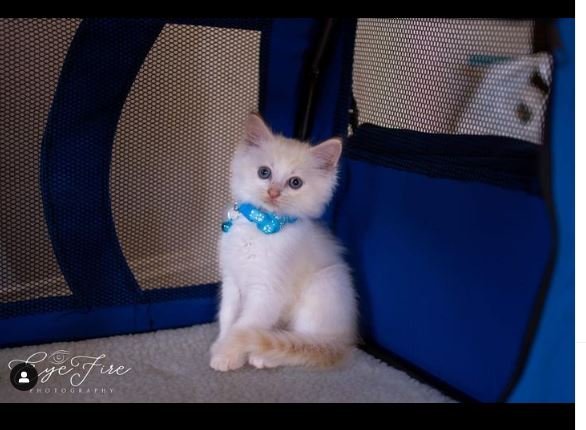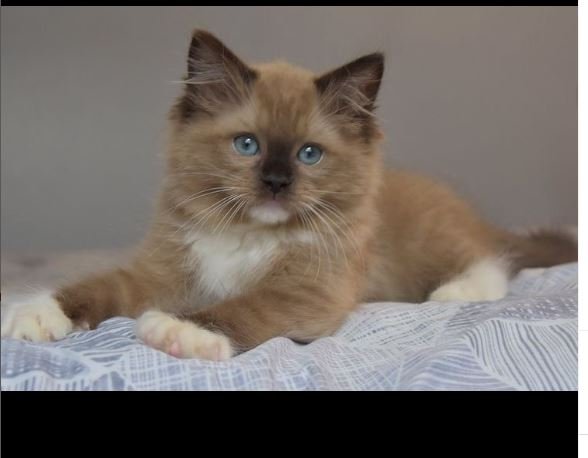If you are looking for a cat that is both stunning and incredibly affectionate, let me introduce you to the Mink Ragdoll. I remember the first time I met a Mink Ragdoll at a friend’s house—their cat, Luna, greeted me with the softest fur I had ever felt and the most beautiful blue-green eyes. She followed us from room to room, always wanting to be part of the action, and when I picked her up, she melted into my arms.
Their personalities are equally wonderful—they are gentle, playful, and love to be with people, making them perfect for families, singles, or anyone who wants a loyal companion.
If you want a cat that is easy to care for, good with children and other pets, even dogs, and always ready to cuddle, the Mink Ragdoll may be a good fit for your home. In this guide, I’ll share everything you need to know about Mink Ragdolls.
What is a Mink Ragdoll Cat?
The Mink Ragdoll is a purebred Ragdoll cat with a unique genetic makeup that gives it a richer, darker coat and aqua (blue-green) eyes. The term “mink” refers to the luxurious, velvety texture of their fur, not to a different breed or specific color.
Unlike traditional Ragdoll cats (seal or blue point), which are born white and develop color over time, Mink Ragdolls are born with visible color and maintain a more uniform, plush coat throughout their lives.
Origin and History of Mink Ragdolls
The Ragdoll breed was created in the 1960s by Ann Baker in Riverside, California. The foundation cat, Josephine, was a white Angora cat whose kittens, after a car accident, exhibited a unique, calm temperament. Josephine was bred with other cats, including Daddy Warbucks and Blackie, to establish the breed.
The Mink Ragdoll bloodline can be traced directly back to the original cats bred by Ann Baker, maintaining a direct connection to the breed’s roots.
Mink Ragdolls began to gain attention in the early 2000s through selective breeding aimed at producing more vivid and eye-catching Ragdolls. Their unique appearance and sweet temperament quickly made them popular among breeders and cat lovers.
Starting May 1, 2025, the cat association TICA (The International Cat Association) will no longer register Mink, Sepia, and Solid Ragdolls as “Ragdolls.” Instead, these cats will be classified under a new breed called the Cherubim (CB). This change reflects a move to preserve the original Ragdoll standard — large, semi-longhaired, pointed cats with blue eyes — while recognizing the unique characteristics of the Mink and similar cats under a different breed name.

Personality Traits
Mink Ragdolls are known for their affectionate, dog-like loyalty. They love following their owners around the house and enjoy being involved in daily activities. Their temperament is gentle and social, and they can often be found snuggling with their human companions.
The easy-going nature of Mink Ragdolls makes them suitable for both quiet and more active households. They tend to have a slightly more interested and fearless spirit compared to traditional Ragdolls, which some owners find endearing.
Mink Ragdoll Colors
Mink Ragdolls are characterized by their deep, rich fur colors, which are one of the most distinguishing features of this unique breed. Unlike traditional Ragdolls, which develop color points gradually after birth, Mink Ragdoll kittens are born with color and maintain a much richer and more saturated coat throughout their lives. Below, we’ll explore the various colors of Mink Ragdolls and how to identify them.
Seal Mink Ragdoll

The seal color is one of the most common and recognizable colors for Mink Ragdolls. Seal Mink Ragdolls have a dark, almost chocolate-brown fur color. The points (ears, face, paws, and tail) are typically a rich, dark brown, while the body fur is a lighter shade of the same deep color. Their body color tends to be a warm cream or brownish color that complements the darker points.
Blue Mink Ragdoll

Blue Mink Ragdolls have a softer, cooler color compared to Seal Minks. The term “blue” refers to a soft grey tone rather than a specific shade of blue. The points are usually a slate grey, and the body fur is a lighter, silvery shade.
Chocolate Mink Ragdoll

Chocolate Mink Ragdolls have a distinct, milk-chocolate color that sets them apart from Seal Minks. Their points are a warm, medium-brown shade, and the body fur is typically a creamy tan or ivory color. They are less common than seals or Blue Minks.
Lilac Mink Ragdoll

Lilac Mink Ragdolls are the rarest among the color variations and are known for their delicate and unique shade. The lilac color is a pale, frosty grey with pink undertones. The points are soft, lavender-grey, and the body fur is a lighter, almost frosty white color.
Flame Mink Ragdoll

Flame Mink Ragdolls, also known as Red Minks. They have bright, reddish-orange points, with the body fur typically being a lighter, cream-colored hue. This color is less common compared to Seal and Blue, but is highly sought after for its striking looks. Flame Minks are easily identified by their bright orange-red accents on their ears, faces, paws, and tails.
Cream Mink Ragdoll
Cream Mink Ragdolls have a very soft and subtle color palette. Their points are a pale cream or light beige color, while the body fur is a lighter, almost off-white shade. Cream Minks are often admired for their understated elegance and gentle appearance. They are among the paler Mink varieties, and their soft, buttery hues make them appear almost glowing.
Seal Sepia and Solid Ragdoll

Sepia and Solid Minks are unique because their color extends throughout their entire coat, rather than just on the points. Seal Sepia Minks have a deep brown color that covers their entire body, creating a uniform look without the lighter body and darker points that traditional Ragdolls have.
Solid Minks can also come in other colors, such as Blue or Lilac, and are characterized by the same color tone across their entire body, making them distinct from the pointed patterns of other Ragdolls.
FAQs
Are Mink Ragdolls purebred?
Yes, they are purebred and trace back to the original Ragdoll cats bred by Ann Baker
Are Mink Ragdolls different in temperament compared to other Ragdolls?
Mink Ragdolls are very similar in temperament to other Ragdolls. They are affectionate, social, and love to spend time with their human family members.
How can you tell a Mink Ragdoll from a traditional Ragdoll?
Mink Ragdolls often have more intense colors and may have aqua or greenish eye colors, whereas traditional Ragdolls typically have blue eyes and lighter fur tones.
Are Mink Ragdolls recognized by CFA and TICA?
TICA recognizes Mink Ragdolls as part of the Ragdoll breed standard, whereas CFA does not specifically recognize them as a separate variant.

Hey guys, My name is Simon Smith. I’m from Canada and live near Victoria
I live with my sweet family and have 20+ Ragdolls of different types. I love them as my children. My profession is as a hotel manager.
I love to keep Ragdolls and grow their breeder case. I have 7 years of experience.
I’m an expert in cat care. So, I’m here to provide you with new information about my cats daily. This is my blog website, so I request that you kindly visit our site daily.
If you’re a Ragdolls lover and you have any questions or confusion about cats, text me on the Contact Us page or Gmail.
Thank u
